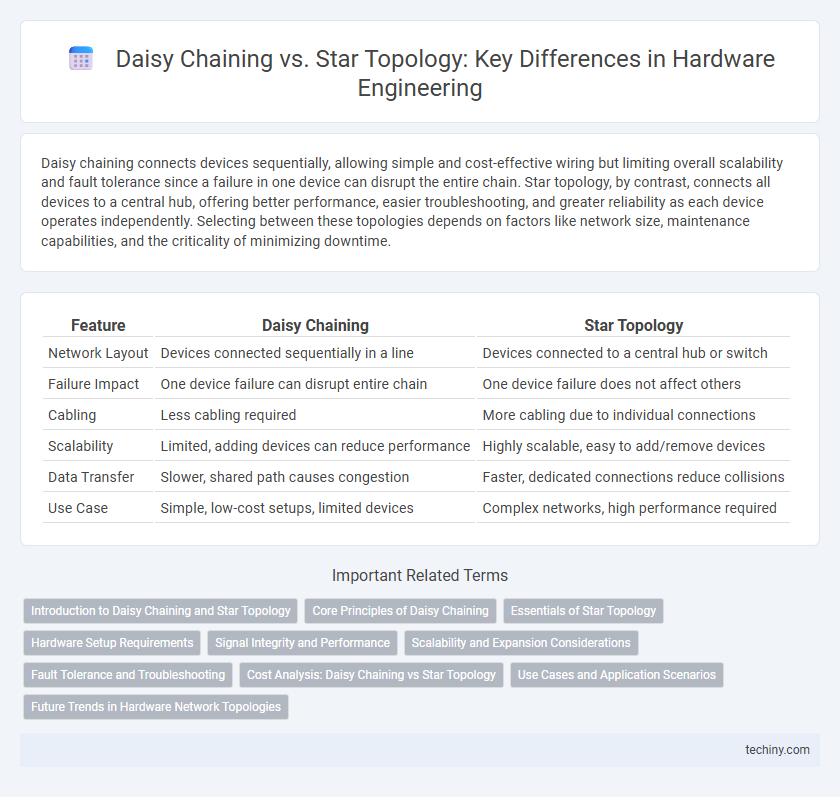Daisy chaining connects devices sequentially, allowing simple and cost-effective wiring but limiting overall scalability and fault tolerance since a failure in one device can disrupt the entire chain. Star topology, by contrast, connects all devices to a central hub, offering better performance, easier troubleshooting, and greater reliability as each device operates independently. Selecting between these topologies depends on factors like network size, maintenance capabilities, and the criticality of minimizing downtime.
Table of Comparison
| Feature | Daisy Chaining | Star Topology |
|---|---|---|
| Network Layout | Devices connected sequentially in a line | Devices connected to a central hub or switch |
| Failure Impact | One device failure can disrupt entire chain | One device failure does not affect others |
| Cabling | Less cabling required | More cabling due to individual connections |
| Scalability | Limited, adding devices can reduce performance | Highly scalable, easy to add/remove devices |
| Data Transfer | Slower, shared path causes congestion | Faster, dedicated connections reduce collisions |
| Use Case | Simple, low-cost setups, limited devices | Complex networks, high performance required |
Introduction to Daisy Chaining and Star Topology
Daisy chaining connects devices in a linear sequence, where each device is linked to the next, simplifying cabling but increasing latency and fault risks. Star topology features a central hub that connects all devices individually, enhancing network reliability and scalability through centralized management. These fundamental hardware engineering network designs determine performance, maintenance, and system expansion capabilities.
Core Principles of Daisy Chaining
Daisy chaining in hardware engineering involves connecting multiple devices sequentially using a single communication line, where each device passes data to the next. The core principles include simplicity in wiring, limited cable length to reduce signal degradation, and the necessity for each device to act as a repeater or router to maintain communication integrity. This topology offers cost-effectiveness but can suffer from increased latency and vulnerability to a single point of failure in the chain.
Essentials of Star Topology
Star topology features a central hub or switch connecting all devices directly, minimizing data collision and improving network reliability. Each device in the star configuration has an independent connection to the central node, allowing easier fault isolation and network management. This centralized structure supports higher data transfer speeds and scalability compared to daisy chaining, where devices are connected in a linear sequence.
Hardware Setup Requirements
Daisy chaining requires minimal hardware setup, involving fewer cables and connectors, making it cost-effective for simple serial device connections. Star topology demands more complex hardware, including a central hub or switch, multiple cables, and increased port availability to ensure each device connects directly to the central node. This setup enhances fault tolerance and performance but increases the overall hardware requirements and installation complexity.
Signal Integrity and Performance
Daisy chaining often leads to signal degradation and increased latency due to cumulative impedance and reflections along the communication line. Star topology enhances signal integrity by providing dedicated point-to-point connections, reducing noise and crosstalk that can impair performance. Optimizing hardware with star topology typically results in higher data rates and more consistent signal quality across devices.
Scalability and Expansion Considerations
Daisy chaining offers limited scalability as each additional device extends the chain and can reduce overall network performance due to increased latency and potential points of failure. Star topology provides superior expansion capabilities by allowing new devices to be added independently to the central hub, minimizing impact on network performance and isolation of faults. For hardware engineering, star topology's centralized control supports easier scalability and maintenance compared to the sequential dependency inherent in daisy chaining.
Fault Tolerance and Troubleshooting
In hardware engineering, star topology offers superior fault tolerance compared to daisy chaining, as each device connects independently to a central hub, allowing easy isolation of faults without disrupting the entire network. Daisy chaining creates a dependency sequence where a single device failure can interrupt communication for all subsequent devices, complicating troubleshooting. Star topology enables faster fault identification and resolution due to centralized monitoring, while daisy chaining requires sequential checks along the chain, increasing downtime and maintenance effort.
Cost Analysis: Daisy Chaining vs Star Topology
Daisy chaining reduces initial hardware costs by minimizing the amount of cabling and network devices compared to star topology, which requires individual cables from each node to a central hub, increasing material expenses. Maintenance and troubleshooting costs tend to be higher in daisy chain setups due to the complexity of isolating faults that impact the entire chain, while star topology localizes failures to individual links, simplifying repairs. Despite higher upfront investment, star topology often results in lower long-term costs by enhancing network reliability and scalability.
Use Cases and Application Scenarios
Daisy chaining is commonly used in hardware engineering for connecting multiple devices in a linear sequence, ideal for applications like LED lighting systems and peripheral devices where minimal cable use and simplified device addition are prioritized. Star topology excels in networked hardware environments such as data centers and server farms, offering improved fault tolerance and easy device isolation, making it suitable for systems requiring high reliability and centralized control. Choosing between daisy chaining and star topology depends on the scale, fault tolerance needs, and complexity of the hardware setup.
Future Trends in Hardware Network Topologies
Emerging hardware network topologies prioritize scalability and fault tolerance, with star topology gaining prominence due to its superior performance in isolating device failures and simplifying maintenance. Daisy chaining faces limitations in bandwidth and latency as device counts increase, driving innovation toward hybrid models that blend hierarchical star and mesh elements for optimized data flow. Advances in programmable hardware and AI-driven network management enable adaptive configurations, ensuring future networks can dynamically adjust topology to meet evolving demands in IoT and high-performance computing environments.
Daisy chaining vs Star topology Infographic

 techiny.com
techiny.com